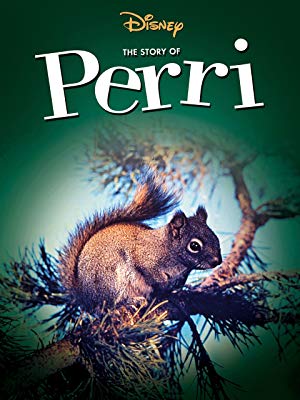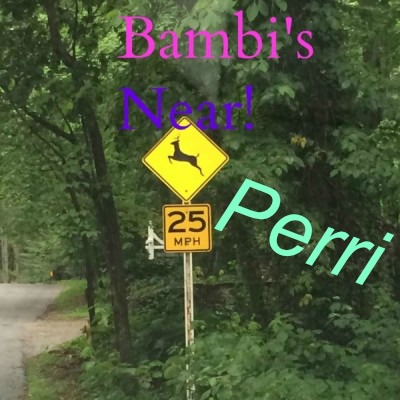
Based on Felix Salten’s 1938 novel Perri: The Youth of a Squirrel, Disney’s Perri was theatrically released on August 28, 1957. The live action nature adventure is seventy-five minutes in length. Perri was the second of six Disney films based on a Salten novel, following Bambi (1942) and preceding The Shaggy Dog (1959, 2006), The Shaggy D.A. (1976), and Bambi 2 (2006). Walt Disney acquired the rights to make Perri on May 4, 1941; at the same time, Salten afforded Disney the movie rights to The Hound of Florence (1923), City Jungle (1932), Bambi’s Children (1939), and Renni (1940); both versions of The Shaggy Dog as well as The Shaggy D.A. were based on The Hound of Florence. (1)
Nature
With great vistas of natural beauty, plenty of animal shenanigans, and no dialogue, Perri is a more sophisticated version of the installments of Walt Disney’s “True-Life Adventures” series, a string of thirteen nature-based films released by the Disney Studio between Seal Island in 1949 and Jungle Cat in 1960. (2) The main difference between the “True-Life Adventures” installments and Perri is the overt plot in the latter; as such, Perri is classified as a “True-Life Fantasy” film. Although only Perri officially garnered this label, other Disney films, including Sammy, the Way-Out Seal (1962), The Incredible Journey (1963), and Charlie, the Lonesome Cougar (1967), followed a similar formula, incorporating a discernable story and oftentimes human characters—there are no human characters in Perri, though—in addition to the antics of nature. (3) Since 2007, Disney has released a series of nature-based documentaries under the “Disneynature” label.
Plot Summary
Perri’s shallow plot explores the evolution of the forest animals of fictional Wildwood Heart, particularly the maturation of a squirrel named Perri. Over the course of approximately one-year, various changes, both expected and unexpected, happy and sad, occur for the animals. The film contains no dialogue, only a narration by Winston Hibler, who also served as the movie’s producer and was named a Disney Legend in 1992. Hibler’s narration is pleasant, poetic, and witty, making for an enjoyable ride in conjunction with the film’s visuals.
Although Perri is the major focus of the film that bears her name, the other animals, not including bears, also receive extended periods of attention. The idea that viewers are witnessing the action through Perri’s eyes is used to justify the detours.
A dream sequence towards the end of the film transports the effort completely into the realm of fantasy. Although somewhat visually interesting, this segment is generally dull and does not add much of value to the film.
A Play
Hibler notes that Perri is a play, and the story indeed unfolds in several acts: a “time of beauty,” a “time of hunting,” a “time of rest,” a “time of learning,” a “time of adventure,” a “time of preparation,” a “time of semi-hibernation,” and “together time.” Although the correlation between these acts and the four seasons is not always concrete, springtime overtly bookends the film.
Conflict
Perri depicts the world as it really functions, not as how it should ideally function. Happiness and love are plentiful in the forest, but a zero-sum game is also apparent, for if one type of animal is to survive, that animal’s prey must die. As such, a good portion of the film features hunting scenarios—among other examples, the marten hunts the squirrel, the raccoon hunts the marten, the goshawk hunts the flying squirrel, and the sapsucker hunts the worm. Hibler well summarizes the predator-prey relationship in the scene early in the movie where Perri’s mother and the mother marten square off: “Will life or death prevail? Two mothers, each with a need; which one will succeed?” These lines also demonstrate the poetic character of the script.
Shortly thereafter, during the “time of hunting,” Hibler offers a blunt assessment of life generally in the forest: “Of course, we must abandon all emotion, all distress and realize that death is just a necessary end—this is the perfect plan that nature has contrived; some must die that others may survive.” Strong stuff for a family movie.
Humor
Hibler’s narration works in tandem with visuals of various animal antics to add much humor to Perri. Along the way, the young raccoons get tangled with their skunk counterparts; the young foxes struggle to eat a mouse; and Perri’s love interest, Porro, endures several relocations in one night.
Hibler utters numerous witty lines that will make you laugh. For example, in narrating a raccoon’s failed attempt to penetrate the martens’ stump, Hibler says, “The raccoon can’t solve the riddle of this tantalizing stump. And, much annoyed, she ambles on her way in search of less-perplexing prey but finds instead another prickly problem.” Indeed, far from finding “less-perplexing prey,” the raccoon is attacked by a porcupine. Ouch!
Music
Perri has what is perhaps among the most-underrated soundtracks in Disney history. The film features three outstanding lyrical numbers— “Break of Day,” “Now to Sleep,” and “Together Time”—in addition to great background music.
My favorite of the lyrical songs, “Break of Day” is a gorgeous number that expresses the beauty of dawn in coordination with nostalgia-inducing visuals of nature at that time of day.
“Now to Sleep” is a soothing lullaby that augments visuals of mothers and children sleeping at night. The song is comparable to “Baby Mine” from Dumbo (1941).
Finally, “Together Time” is an upbeat number that exudes the happiness of the spring mating season. This song is performed twice, once following the dream sequence and again in the movie’s last scene.
In addition to the lyrical songs, Perri’s background music is utilized excellently. For example, ominous music complements Perri’s foray into the eerie “grove of the crooked aspen”; suspenseful tunes accompany the various animal chases; and, in perhaps the movie’s most stunning scene, the music is coordinated to synchronize with the snow falling from the trees.
Relationship to Other Disney Films
Bambi makes a “cameo” in Perri. Characters from previous Disney films also reappeared in The Three Caballeros (1945), Fun and Fancy Free (1947), Melody Time (1948), One Hundred and One Dalmatians (1961), The Black Cauldron (1985), The Great Mouse Detective (1986), Aladdin (1992), The Hunchback of Notre Dame (1996), Lilo and Stitch (2002), Treasure Planet (2002), Meet the Robinsons (2007), The Princess and the Frog (2009), Tangled (2010), Wreck-It Ralph (2012), Frozen (2013), Big Hero 6 (2014), Zootopia (2016), and Moana (2016). (4)

Winston Hibler also narrated Seal Island, In Beaver Valley (1950), Nature’s Half Acre (1951), Water Birds (1952), Bear Country (1953), The Vanishing Prairie (1954), White Wilderness (1958), and King of the Grizzlies (1970) for Disney. Hibler subsequently served as a producer for Disney for The Hound That Thought He Was a Raccoon (1960), Nikki, Wild Dog of the North (1961), Big Red (1962), Those Calloways (1965), The Ugly Dachshund (1966), Follow Me, Boys! (1966), Charlie, The Lonesome Cougar, The Horse in the Gray Flannel Suit (1968), King of the Grizzlies, The Aristocats (1970), Napoleon and Samantha (1972), One Little Indian (1973), The Bears and I (1974), The Castaway Cowboy (1974), and The Island at the Top of the World (1974).
Surreal dream sequences are also included in Dumbo, The Three Caballeros, and The Many Adventures of Winnie the Pooh (1977).
The relationships among animals and nature are also a major theme in Bambi, The Fox and the Hound (1981), and The Lion King (1994).
A deadly fire is featured at the end of Perri. Fires were also prominently seen in Bambi, Bolt (2008), and Big Hero 6.
In the Parks
A plethora of animals can be seen throughout Walt Disney World’s Animal Kingdom theme park.
The relationships among animals and nature were highlighted in two film attractions, “Symbiosis” and “The Circle of Life: An Environmental Fable,” at Epcot, which operated in The Land pavilion from 1982 to 1995 and 1995 to 2018, respectively.
Overall
Perri’s plot isn’t overly exciting on its own terms, but Hibler’s calm and witty narration, frequent animal antics, philosophical undertones, and an outstanding score result in an enjoyable film.
Notes
1) Douglas W. Churchill, “Screen News Here and in Hollywood: Walt Disney Acquires Rights to 5 Works by Felix Salten—Fox Seeks Pidgeon,” New York Times, May 5, 1941, Amusements sec., accessed October 18, 2018, New York Times Historical (1851-2010).
2) Jim Korkis, “Walt and the True-Life Adventures,” The Walt Disney Family Museum, February 9, 2012, accessed September 27, 2018, https://www.waltdisney.org/blog/walt-and-true-life-adventures.
3) Ibid.
4) “List of Cameos in Disney Films,” The Disney Wiki, accessed October 22, 2018, http://disney.wikia.com/wiki/List_of_cameos_in_Disney_films; Dave Smith, Disney Trivia from the Vault: Secrets Revealed and Questions Answered (New York: Disney Editions, 2012), 10.
What do you think of Perri? Let me know in the comments!
Incoming search terms:
- https://www themouseforless com/blog_world/movie-review-perri/
- disney perri
